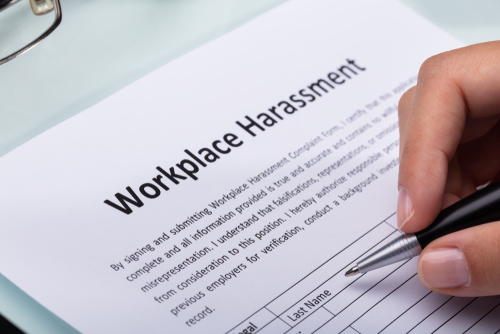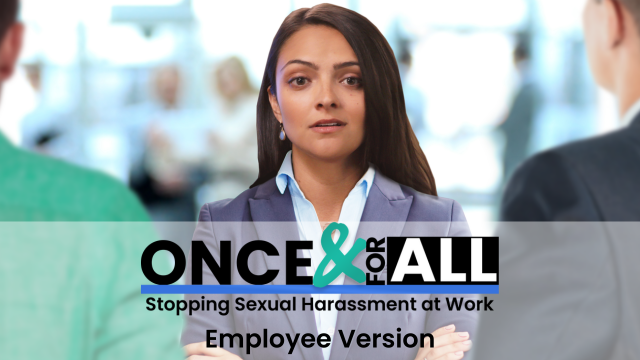What is Harassment?
Harassment is a term that falls under the umbrella of discrimination. Simply put, discriminating against an individual means treating them differently or less favorably for a particular reason. Often, that discrimination happens in the workplace. When it does, it’s referred to as employment discrimination.
In the United States, the government’s Equal Employment Opportunity Commission (EEOC) is the agency responsible for enforcing federal laws that make employment discrimination illegal. According to the EEOC:
Harassment is unwelcome conduct that is based on race, color, religion, sex (including sexual orientation, gender identity, or pregnancy), national origin, older age (beginning at age 40), disability, or genetic information (including family medical history).
Sexual Harassment in the Workplace
Sexual Harassment is one of the most publicized and stubbornly prevalent trypes of discrimination that that typically involves illegal sexual misconduct in workplaces and has the potential to cause lasting harm to individuals, teams, and organizations.
For more information, see Media Partners' Sexual Harassment Prevention solution page.
When Behaviors Become Harassment
The EEOC specifies that behavior crosses the line of propriety and is deemed unlawful when either (or both) of these conditions occur:
- An individual must endure the offensive conduct as “a condition of continued employment.”
- The conduct is so pervasive or severe that it creates “a work environment that a reasonable person would consider intimidating, hostile, or abusive.”
Examples of offensive conduct cited by the EEOC include: “offensive jokes, slurs, epithets or name calling, physical assaults or threats, intimidation, ridicule or mockery, insults or put-downs, offensive objects or pictures, and interference with work performance.”
It is important to note that the EEOC’s examples are not comprehensive illustrations of harassment—other behaviors may create a hostile or abusive workplace environment and should be reported and examined on a case-by-case basis.
Notably, retaliation against those who file charges of discrimination in the workplace—or those who testify as witnesses or participate in investigations—is considered harassment, too, and is prohibited by law. This extends to individuals who formally oppose organizational practices they believe are in violation of federal anti-discrimination laws. Fear of retaliation is a leading reason why employees choose not to report incidents of workplace harassment.
Defined by the Workplace Bullying Institute, a research and advocacy organization:
Workplace bullying is repeated, health-harming mistreatment by one or more employees of an employee: abusive conduct that takes the form of verbal abuse; or behaviors perceived as threatening, intimidating, or humiliating; work sabotage; or in some combination of the above.


The Institute notes that most workplace bullying (80%) is not illegal, nor is it considered to be a form of discrimination unless the individual being bullied has been targeted because of the criteria that falls under EEOC jurisdiction: race, color, religion, sex (including sexual orientation, gender identity, or pregnancy], national origin, older age (40 or more years), disability, or genetic information (including family medical history).
Further, employment law experts add, bullying becomes illegal when it meets the additional criteria the EEOC has specified for harassment: “the offensive conduct becomes a condition of continued employment or the conduct is severe or pervasive enough to create a work environment that a reasonable person would consider intimidating, hostile, or abusive.”
Most commonly, the legal experts say, employers try to bully workers who have made some type of formal complaint. If proven, such behavior could constitute unlawful retaliation and form the basis for legal action.
Especially when harassment at work sets up a situation in which tolerating abuse is necessary in order to keep one’s job, it’s natural to imagine that the problem is caused by supervisors or others in positions of power. In fact, the EEOC points out, harassers are not limited to those in management:
- The harasser can be the victim's supervisor, a supervisor in another area, an agent of the employer, a co-worker, or a non-employee.
- The victim does not have to be the person harassed, but can be anyone affected by the offensive conduct.
- Unlawful harassment may occur without economic injury to, or discharge of, the victim.
About Workplace Harassment
56%
Employees who say they've witness inappropriate/illegal behavior on the job
64%
Employees who reported the inappropriate behavior
46%
Employees who fear retaliation for reporting harassment
39%
Employees who believe harssment reports won't be handled fairly
Disrespectful workplaces in which harassment and other forms of discrimination are allowed to occur cause harm not only to the individuals involved, but to the organization as well.
In fiscal year 2020, the EEOC received 24,221 formal complaints involving various kinds of workplace harassment, including charges of sexual harassment. While the agency has jurisdiction over most employers with at least 15 employees (20 employees in age discrimination cases) and most labor unions and employment agencies, the complaints the EEOC receives represent only a fraction of the harassment issues that continue to plague workplaces. A 2020 study reported that only 20% of analyzed harassment claims were reported to the EEOC.
Individuals who are victims or witnesses of harassment and other kinds of discrimination, some types of potential damage can include physical harm, mental trauma and anguish (such as PTSD, depression, and anxiety), negative impacts on career and professional growth (including job loss, increased absenteeism, and disengagement), decreased productivity and performance, emotional and financial damage for family members, and much more.
Organizations that fail to act when harassment is observed or reported may see their employer brand suffer; a decline in the ability to attract and retain top talent; and decreases in employee engagement, productivity, morale, teamwork, collaboration, and other critical functions. Ultimately, companies can experience significant reductions in overall performance and loss of customers.
Further, there are financial ramifications for employers. Beyond the costs of increased worker turnover and reduced profits, legal penalties associated with litigation or other actions related to harassment and discrimination can be significant. In 2020, for example, the EEOC reported a 16-year high in monetary recovery for victims. For harassment claims, alone, recovery from employers amounted to more than $137 million.
Employers have a duty to ensure that their workforces can expect to perform their jobs in conditions that are both safe and respectful to all. But with tens of thousands of instances of workplace harassment occurring every year, how can companies expect to change unsafe environments to respectful and inclusive settings in which discrimination has no place?
Success in reducing harassment (and other forms of discrimination) at work begins with a sincere commitment from organizations, and that calls for company values that formally affirm respect and a safe working environment for all. Further, those values must be communicated clearly and often, then modeled by organizational leaders through their own respectful and inclusive behavior.
Company policies and practices must also reinforce an organization’s dedication to respectful and harassment-free workplaces. Formal policies help structure daily work practices that encourage respect and discourage discrimination. They also provide a basis for accountability. Moreover, they spell out the actions individuals can take to report harassment and what corresponding actions can be expected of the organization when such reports are received. This helps ensure that reported incidents are not overlooked or ignored.
In addition to reinforcing its support for leadership involvement, effective policies, accountability, and other specific actions to curb harassment, the EEOC underscores the critical role a purposeful and effective program of training plays in addressing workplace harassment. In particular, charging leaders with ensuring that organizations:
- Regularly and effectively train all employees about the harassment policy and complaint system.
- Regularly and effectively train supervisors and managers about how to prevent, recognize, and respond to objectionable conduct that, if left unchecked, may rise to the level of prohibited harassment.
The EEOC’s extensive training recommendations are embodied in the award-winning training content and materials offered by Media Partners. Programs such as How Was Your Day: Getting Real about Bias, Diversity and Inclusion, and Harassment offer comprehensive solutions in versatile formats to help organizations build inclusive and respectful cultures and the workplaces that reflect them. Employee and Manager versions are available.
Unintentional Still Hurts: Overcoming Unconscious Bias: This powerful new implicit bias training goes beyond the basics, focusing on impact vs. intent, the concept of microaggressions, and practical ways to identify, challenge, and respond to bias.
Once & For All: Stopping Sexual Harassment at Work: Worry-free sexual harassment prevention training is here with Once & For All. Just revised for 2022, It is the most effective training for inspiring immediate behavior change and building a culture of respect...and is the only program with a compliance guarantee.
Sexual Harassment Prevention Training: Your Guide to a Successful Result: Ensure attempts to prevent sexual harassment in your workplace are effective. This post covers everything you need to know about sexual harassment training.
Respectful Workplace Training: Everything You Need to Know: Explore everything you need to know about respect in the workplace & respectful communication. Require staff training & support job satisfaction.








